

Entangled Photon Emitter That Fits in Computer Chip Developed. Researchers at the Università degli Studi di Pavia in Italy has developed a component that can generate a steady stream of entangled photons.
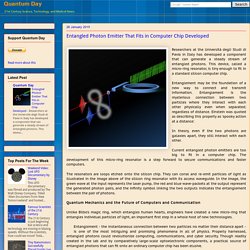
This device, called a micro-ring resonator, is tiny enough to fit in a standard silicon computer chip. Entanglement may be the foundation of a new way to connect and transmit information. Entanglement is the mysterious connection between two particles where they interact with each other physically even when separated; regardless of distance. Einstein was quoted as describing this property as 'spooky action at a distance'. Atomic Force Microscope Manipulate Atoms to Form Smallest Swiss Cross.
Researchers from Finland and Japan have formed the smallest Swiss cross using bromide atoms on a sodium chloride surface.
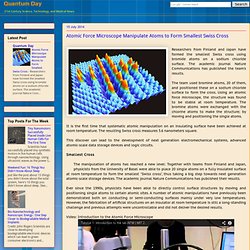
The academic journal Nature Communications has published the team's results. The team used bromine atoms, 20 of them, and positioned these on a sodium chloride surface to form the cross. Using an atomic force microscope, the structure was found to be stable at room temperature. Biodegradable Medical Implants Being Developed. Scientists are close to developing biodegradable electronic devices which can lead to green consumer electronics and bio-resorbable medical devices that are rendered completely harmless after performing its job.
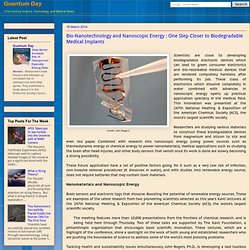
These class of electronics which dissolve completely in water combined with advances in nanoscopic energy opens up practical application specially in the medical field. This innovation was presented at the 247th National Meeting & Exposition of the American Chemical Society (ACS), the world's largest scientific society. Researchers are studying various materials to construct these biodegradable devices from magnesium and silicon to silk and even rice paper.
Combined with research into nanoscopic energy (using power sources such as thermodynamic energy or chemical energy to power nanomaterials), medical applications such as studying the brain after head injuries, and other body sensors that vanish once its work is done are slowly becoming a strong possibility. Nanotechnology Transparent Screen. Low Cost, High Definition Transparent Display Developed Through Nanotechnology. Researchers from MIT and Harvard departments of Physics, and the US Army Edgewood Chemical Biological Center have teamed up to develop a low cost, scalable, and high resolution display system using nanoparticles that can be displayed on transparent glass.
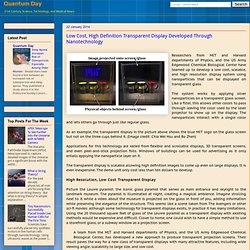
The system works by applying silver nanoparticles on a transparent glass screen. Like a filter, this allows other colors to pass through leaving the color used by the laser projector to show up on the display. The nanoparticles interact with a single color and lets others go through just like regular glass. As an example, the transparent display in the picture above shows the blue MIT logo on the glass screen but not on the three cups behind it. Ocean Proof Mobile Phones Through Atomic Layer Deposition and Barrier Films. Scientists have developed a barrier film through through a molecular process called atomic layer deposition (ALD) that can protect objects such as mobile phones from harsh environments such as salt water.
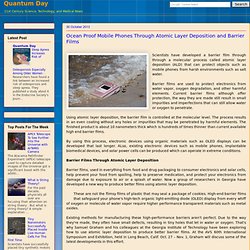
Barrier films are used to protect electronics from water vapor, oxygen degradation, and other harmful elements. Current barrier films although offer protection, the way they are made still result in small impurities and imperfections that can still allow water or oxygen to penetrate. Using atomic layer deposition, the barrier film is controlled at the molecular level. The process results in an even coating without any holes or impurities that may be penetrated by harmful elements. The finished product is about 10 nanometers thick which is hundreds of times thinner than current available high end barrier films. Ultrafast Laser Accelerator Built on a Nanosized Glass Chip.
Scientists from the U.S.
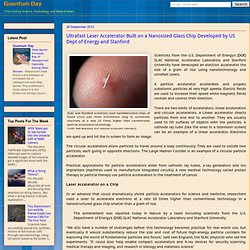
Department of Energy's (DOE) SLAC National Accelerator Laboratory and Stanford University have developed an electron accelerator the size of a grain of rice using nanotechnology and ultrafast lasers. A particle accelerator accelerates and propels subatomic particles at very high speeds. Electric fields are used to increase their speed while magnetic fields contain and control their direction. Nanotechnology Based Vaccine Developed Provides Efficient, Targeted, and Needle-Free Protection.
Engineers at the Massachusetts Institute of Technology have developed a nanoparticle that can be used as an efficient and targeted drug delivery system for vaccines.

The development of the nanoparticle addresses the challenge of dispensing a vaccine through the lungs via an aerosol spray without activating an immune response that neutralizes it. Vaccines that are dispensed through mucosal points of entry like the nasal cavities have certain advantages such as not requiring a needle, specially during outbreaks where dispensing medication through an aerosol spray is faster, safer, and more econmical. Mucosal vaccines are a bit challenging since the vaccine has to go through the body's mucosal barrier. This barrier of mucus prevents foreign particals from getting into the body. This recently developed nanocapsule can go through this barrier and go directly to the lungs. The vaccine can survive in the lungs long enough for it to be delivered to T-cells. Sturdier vaccines. Nanoplasmonic Bubble Lens Controls Focus and Direction of Light.
Scientists have developed a reconfigurable plasmofluidic lens using nanoplasmonics that can control light waves at the nanoscale.

The nanoscale light beam is modulated by surface plasmon polaritons (SPP) which are short electromagnetic waves. The light wave is controlled by the bubble lens which can control the focus and direction of light. Nanoplasmonics is a new field of science that deals with the behavior of metal particles at the nanoscale and its optical properties. At the nanoscale, light or electromagnetic waves approaches half the size of its wavelength. At this level, the electrical field of light displaces the metal's electrons producing an oscillating field or what is called a surface plasmon. Ancient stained glass windows (which contains gold and silver particles) use nanoplasmonic properties to attain its deep vibrant colors when light passes through it.
Heat Dissipation at the Atomic Level Studied Through Nanotechnology. Researchers at the University of Michigan are studying the effects of heat at the nanoscale; between atoms.
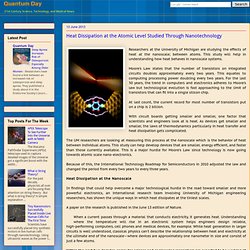
This study will help in understanding how heat behaves in nanoscale systems. Moore's Law states that the number of transistors on integrated circuits doubles approximately every two years. This equates to computing processing power doubling every two years. For the last 50 years, the trend in computers and electronics adheres to Moore's law but technological evolution is fast approaching to the limit of transistors that can fit into a single silicon chip. UC-Riverside Abstract On Using LiFePO4 Nanorods As A Cathode Lithium Ion Batteries. University of California-Riverside presented its research on its use of water-triethylene glycol (TEG) as a solvent to synthesize LiFePO4 (LFP) nanorods with uniform size during a meeting of the American Chemical Society as part of the 245th National Meeting & Exposition of the American Chemical Society.

The following is the abstract of that presentation. Solvothermal synthesis, growth mechanism, and performance of LiFePO4 nanorods used as a cathode material in lithium ion batteries David Kisailus, University of California-Riverside Phone: 951-827-2260 Email: david@engr.ucr.edu. Rochester Institute of Technology Abstract on Replacing Metal Current Collectors with Carbon Nanotubes. Rochester Institute of Technology presented its research on replacing metal current collectors with carbon nanotubes in battery electrodes.
The research was presented at a meeting of the American Chemical Society as part of the 245th National Meeting & Exposition of the American Chemical Society. The abstract of the research on CNT follows: Enhanced lithium ion battery energy density with carbon nanotube current collectors. Michigan Technological University Research on Nanostructured Anode Materials in Lithium Ion Batteries. Michigan Technological University presented its research on nanostructured anode materials such as silicon nanorods and titanium dioxide nanotubes as anode materials for lithium ion batteries. University of Houston Presents Improving Energy Density and Cycle of Life of Silicon Anodes with Nanotechnology.
Nanodiamond-derived carbon nano-onions (N-CNOs) As Material for Lithium Ion Batteries. University of Kentucky during the 245th National Meeting & Exposition of the American Chemical Society, presented its research on nanodiamond-derived carbon nano-onions (N-CNOs) as anode materials for lithium-ion batteries due to their high capacity and stable cycling performance. The abstract is as follows: Nanodiamond-derived carbon nano-onions as negative electrode materials for lithium-ion batteries Mahendra K Sreeramoju, University of Kentucky Phone: 859-257-5393 Email: mksree2@uky.edu. Nanotechnology Research Develops New Photovoltaic Process Using Gold Nanorods. Researchers in Photovoltaic technology have developed a new method in converting sunlight into electrical energy using gold nanorods.
Research into photovoltaic energy (converting solar rays into electrical energy) has benefited a lot from materials technology and nanotechnology. The main process of a photovoltaic cell or solar cell is using the photons from the sun's rays to basically move electrons around to generate electricity. Storing Digital Information in DNA May Be Commercially Viable In The Near Future. Researchers at the European Molecular Biology Laboratory and the European Bioinformatics Institute (EMBL-EBI) have developed a process that would make storing digital information in DNA commercially viable. Deoxyribonucleic acid (DNA) are biological molecules containing genetic information used in the development and function of all known living organisms. MIT News: Polymer Film Uses Water Vapor to Harvest Energy and Generate Electricity For Nanodevices.
MIT News: Manipulating Heat Using Lenses and Mirrors. Nanostructured semiconductor alloy crystals were engineered to manipulate heat, either through reflecting or focusing it. Wearable Technology Leads To Clothes That Can Help Rehabilitate Physical Conditions. Researchers have developed a low cost wearable strain sensor that can be used for correcting and rehabilitating physical problems such as posture or flexibility issues of patients. As technology approaches the nano scale, devices are getting smaller and smaller that it can now be integrated into the clothes people wear.
This advancement in science and engineering is known as Wearable Technology. New Advancements In DNA Nanotechnology Lead To Development of Practical Applications. A breakthrough in the understanding of DNA nanotechnology may lead to faster and more efficient ways to manipulate DNA into artificial structures and molecules. DNA nanotechnology is the science of manipulating nucleic acid like DNA and RNA to form artificial structures.
DNA is responsible for storing, transmitting, and encoding genetic information. With DNA nanotechnology, it is used for bio-engineered applications. DNA is known for its structure; the double helix. Nanotechnology and Plastics Develop New Type of Lighting That is Flicker-Free, Bendable and Shatterproof. Researchers develop cost-effective way to spin nanoscale fibers. Thermodynamics Used To Grow Nanorods Into Superparticles With Precision. Nanorods are a particular shape of nanoparticles. They are elongated and are similar to a hotdog and can range in size from 1 nanometer (nm) to 100nm, where 1nm= 1x10-9 meters (one-billionth of a meter). Nanoparticles can also form into spheres and flattened sheets.
Nanorods are produced through chemical synthesis. A metal or semiconducting material are combined with several chemicals to produce nanoparticles of that element. They are then subjected to another series of processes to produce the desired shape and filter out unwanted particles. Because of their shape and size, nanorods interact with light, electricity and magnetic fields differently. Nanophotonics Allow Color Manipulation A Few Atoms Wide With Opaque Objects. Nanophotonics is the study that has anything to do with light at the nanoscale level.